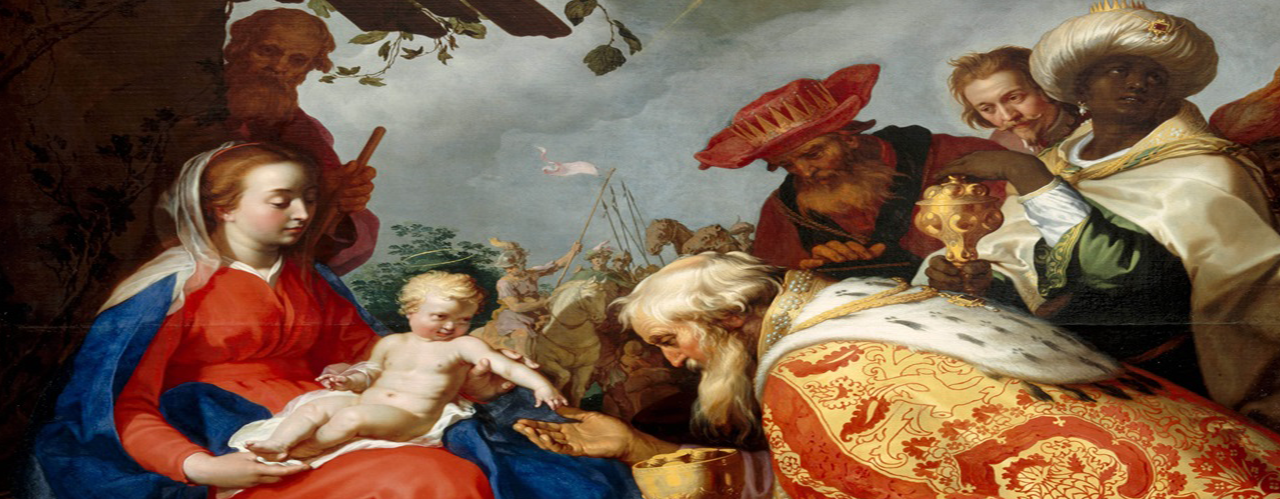If you want to help people see Christmas with fresh eyes, start by dropping these familiar fallacies.(Abraham Bloemaert / Wikimedia Commons.The adoration of the Magi)
Pastors, preachers, and Bible teachers: Have you thought about your Christmas sermon or lesson yet? If you want to help people celebrate Christmas this year (and every year) in keeping with established facts—not later legends, traditions, or popular imaginations—start by avoiding these common mistakes.
1. Don’t add details that aren’t in the text.
This might seem obvious but bears repeating because it happens so often. The massive annual proliferation of Christmas cards, nativity scenes, and TV specials perpetuates these added details and gives the impression that they are facts.
The infancy narratives in the Gospels lack many of the details that have been fabricated in subsequent centuries. For example, they don’t tell us about the nature of the stable (cave, open-air, wood, etc.); whether there even was a stable; whether or not there were animals nearby; or the number of wise men. These magoi (not kings and not necessarily three in number) almost certainly didn’t arrive on the night of the birth as most manger scenes depict. And a star wouldn’t have been suspended right above the roofline. With no mention of a stable, the manger could have been in the open air, in an animal pen near the house, in a small cave, or in the area of a house used for animals.
The texts don’t mention Mary and/or Joseph riding on a donkey. It is equally plausible—if not more so—that they walked the entire way from Nazareth to Bethlehem (70–80 miles; at least 3 days of steady walking). The idea of Mary riding a donkey stems from a second-century apocryphal work (Protoevangelium of James, chap. 17). Actually, it wouldn’t have been unreasonable for a pregnant teenager in antiquity with an active lifestyle to walk such a journey.
Despite what we see in some Christmas pageants, there is no mention of an innkeeper (whether mean and coldhearted or regretful for the lack of space available); Luke simply mentions that there was no room in the kataluma (Luke 2:7). The kataluma was not a formal professional inn with an innkeeper but could point to either a public covered shelter (as in the Greek translation of Ex. 4:24) or to the guest room in a personal home (as in Luke 22:11).
It is important for us to stick with established facts when preaching and teaching. There is, of course, nothing wrong with the use of historical imagination. But it is important to maintain a clear distinction between what we actually know happened and imaginative reconstructions of how events might have taken place. Christianity is rooted in historical fact. This is as true for Jesus’ birth as it is true for the crucifixion and resurrection.
2. Don’t supply spiritual explanations for cultural practices to make them sound biblical.
We love to find—or even invent—spiritual reasons for various cultural practices related to Christmas. For example, we give gifts to one other to remind ourselves of God’s great gift of Jesus to the world or of the gifts of the wise men to Jesus. That may sound nice, but is it biblical? Or do we really give gifts because that’s what our parents did and what everyone else we know does (except the Jehovah’s Witnesses, diehard secularists, and some religious purists)? What kind of parent would you be if you didn’t give your child a Christmas present (or, in many cases, a whole roomful of them)? Or, just imagine, if you didn’t celebrate Christmas at all (like the Puritans)? Very little is intrinsically spiritual or biblical about these kinds of expectations. They’re almost entirely cultural. That doesn’t make them necessarily wrong, but we shouldn’t invent biblical rationales to justify them.
Examples abound. What does the decoration of an evergreen tree have to do with Jesus’ coming to earth to rescue God’s creation? We may tell ourselves it’s a symbol of everlasting life because it’s evergreen but is that really the reason to set up a Christmas tree each year? Similarly, we may point to candles as a symbol of Jesus being the light of the world, holly as a symbol of the crown of thorns that was placed upon Jesus’ head, the color red as a symbol of Jesus’ blood shed on the cross, the yule log as a symbol of the cross, mistletoe as a symbol of reconciliation, and bells as a symbol for ringing out the good news. Even if some of these associations and symbols are ancient, they don’t explain why we should necessarily incorporate them in our Christmas celebrations today. If we’re honest, we have to admit that we celebrate Christmas the way we do primarily because of our own cultural traditions, even though there’s little real connection between these traditions and the biblical accounts of Jesus’ actual coming to this earth as a baby.
The danger of infusing spiritual rationales into cultural practices is also seen in some of the Christmas songs we sing at church during the month of December. The most flagrant violation might be “O Christmas Tree.” You have to search hard through the stanzas of this hymn to find anything related to Jesus. We should be uncomfortable singing this carol in a gathered group of Christians because it’s basically a song paying homage to a tree. Just because the song has been culturally or traditionally associated with Christmas doesn’t mean we should incorporate it into our Christian Christmas celebrations.
The main danger here is that we present cultural practices as if they carry biblical weight or authority. Obscuring the line between cultural practice and biblical teaching is not only unhelpful and confusing, but also potentially harmful to our faith. When we no longer distinguish what’s biblical from what’s cultural, we run the risk of accepting and propagating syncretistic, hodgepodge ideas that have no biblical basis. Our faith is no longer based in truth but, at least in part, on myths and legends.
There is no need, of course, to abandon all these cultural practices in our family celebrations. We should simply maintain and communicate a clear distinction between the aspects of our Christmas celebration that are inherited from the culture and those that are clearly grounded in Scripture.
3. Don’t be embarrassed by the Jewishness of passages related to Jesus’ coming.
The first chapter of Luke includes two lengthy hymns that have traditionally been called the Magnificat (Mary’s song in Luke 1:46–56) and the Benedictus (Zechariah’s song in Luke 1:67–79). The titles come from the first word of these hymns in Latin. These passages—or at least parts of them—are at times neglected because they are rather lengthy and express Jewish hopes in God’s salvation without a clear indication of what that salvation would look like. This deliverance, as we know it in retrospect, comes in the form of Jesus’ death and resurrection, the expansion of the gospel beyond Israel to the Gentiles, and Jesus’ return at the end of time.
The Magnificat celebrates how God, through Mary’s child, will restore and help Israel while opposing her enemies and oppressors. The Benedictus describes John the Baptist’s role in relation to Jesus, the main figure in the fulfillment of God’s plan to restore Israel. The hymn praises God’s actions of visiting and redeeming his people by raising up the Davidic Messiah to deliver his people, all in fulfillment of his promises to Abraham and to his people through the Old Testament prophets. This deliverance will enable God’s people to serve God without fear and in righteousness forever.
Perhaps these hymns are at times neglected in our Christmas sermons because they’re not “Christian” enough. This neglect, however, comes at a serious loss. Both hymns describe the salvation that will result from Jesus’ coming to earth. During his first coming, he decisively dealt with his people’s sin, thus fulfilling passages such as Micah 7:18–20. We’re still waiting for his second coming, when he will set things right in every way—politically, economically, socially, and spiritually—once and for all. We are still waiting for the full and final fulfillment of the declarations made in the Magnificat and Benedictus. Both hymns are also powerful examples of how to praise God by focusing both on his attributes—his power, holiness, and mercy—and his actions in fulfilling his ancient promises to his people in and through the birth of Jesus the Messiah.
The Christian faith is rooted inextricably and inexorably in the Jewish faith. This is why even Luke, a Gentile, presents Jesus’ coming in terms of Old Testament fulfillment (Luke 1:1). Like Matthew, who wrote his Gospel primarily to Jews, Luke presents Jesus’ coming in a thoroughly Jewish cast. If we fail to see our Christian faith rooted in God’s dealings with his people Israel long ago, it will likely remain shallow and leave us with a truncated gospel and canon, not to mention an inadequate understanding of who Jesus is and why he came.
4. Don’t be swayed by dubious challenges to the biblical witness to Jesus’ birth.
Both birth narratives in Scripture are replete with manifestations of supernatural events surrounding the Virgin Birth: angelic appearances, dreams, visions, prophecies made regarding Jesus, Elizabeth conceiving past the age of childbearing, Zechariah losing his speech, the circumstances surrounding the naming of both John and Jesus, the relationship between the two births, and so on. Matthew, for example, goes out of his way to make clear that Mary was Jesus’ mother, but that Joseph was not his real father. After a long string of references to men “fathering” a son, Matthew concludes his genealogy with reference to “Joseph the husband of Mary, of whom Jesus was born, who is called Christ” (Matthew 1:16, italics added), indicating that Joseph was not Jesus’ real father. Jesus was conceived by the Holy Spirit in Mary’s womb.
So let’s not be intimidated by critical objections to the Virgin Birth or other supernatural aspects of the Christmas story. When you read about authors such as Reza Aslan claiming that stories about Jesus’ birth and childhood are “conspicuously absent” from the earliest New Testament writings—such as Paul’s letters and Mark’s Gospel—and that the early Christians filled in the gaps to align Jesus’s life with various Old Testament prophecies, including those related to his birth, don’t be alarmed. According to Aslan, the early Christians concocted the myth of Jesus’ birth in Bethlehem in order “to get Jesus’s parents to Bethlehem so he could be born in the same city as David.” Others, such as Andrew Lincoln, deny the historicity of the Virgin Birth on similar grounds. We can’t respond in detail here, though we’ve done so elsewhere. In short, these kinds of arguments reflect misguided attempts to drain the biblical birth narratives of their transcendent elements by using critical reasoning in order to reinterpret supernatural occurrences and to rewrite the narratives in purely naturalistic terms.
On the one hand, as already mentioned, let’s be careful ourselves not to add extraneous details—though driven by tradition, not critical reasoning. Let’s be adamant in defending the reliability of the biblical witness to the supernatural nature of Jesus’ birth, which was unlike any other in human history. The Bible is unequivocal, and careful historical research certainly allows for the fact that it took a miracle—in fact, a whole string of miracles—to save us. That is nothing to be embarrassed or intimidated about.
5. Don’t get bogged down in trivia and miss the true significance of Jesus’ birth.
Scholars continue to debate questions such as the year of Jesus’s birth, and whether or not Jesus was born on December 25. They debate the historicity of Quirinius’s census, the year of Herod the Great’s death, the phenomena surrounding Jesus’ birth—the star of Bethlehem—and a host of related chronological and other issues. They also debate the possible pagan origins of Christmas, such as whether it provided a functional substitute for the Roman Saturnalia, and, as mentioned, the emergence of various other traditions associated with our celebration of Christmas. All of these are interesting questions worth exploring, but don’t dwell unduly on such peripheral issues. Instead, focus on the central message of Jesus’ first coming, on the biblical story of the Incarnation.
Who was Jesus, and why did he come? John’s Gospel roots Jesus’ origins in eternity past, as the Word who was in the beginning with God and was himself the agent of creation. According to John, in Jesus, God visited the world he had made, but his own did not receive him (1:11). How tragic! How inexcusable! That Word, John tells us, became flesh in Jesus, or, as John puts it, “pitched his tent” among us (1:14). In his three and a half years of ministry, Jesus trained the twelve disciples and others to carry on his mission, to take the gospel of salvation to the ends of the earth. Then, he died for us on the cross to pay for our sins and to reconcile us to God. Our broken relationship with God was mended. Those who trust in him enjoy deep spiritual fulfillment and continual connection with him already in the here and now and will do so for all eternity.
That’s worth celebrating, at Christmas and throughout the year, in joyful song and in a life dedicated to the glory of God in the highest of which the angels sang that starry night over two millennia ago.
Andreas Köstenberger is Senior Research Professor of New Testament and Biblical Theology at Southeastern Baptist Theological Seminary in Wake Forest, North Carolina. Alex Stewart is Academic Dean and Assistant Professor of New Testament Language and Literature at Tyndale Theological Seminary in Badhoevedorp, The Netherlands. They co-authored The First Days of Jesus: The Story of the Incarnation (Crossway, 2015).






